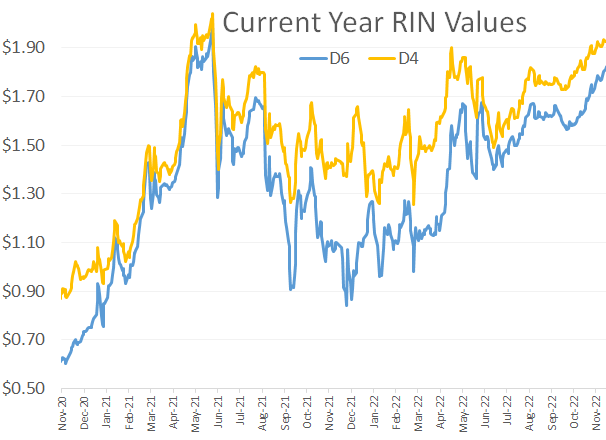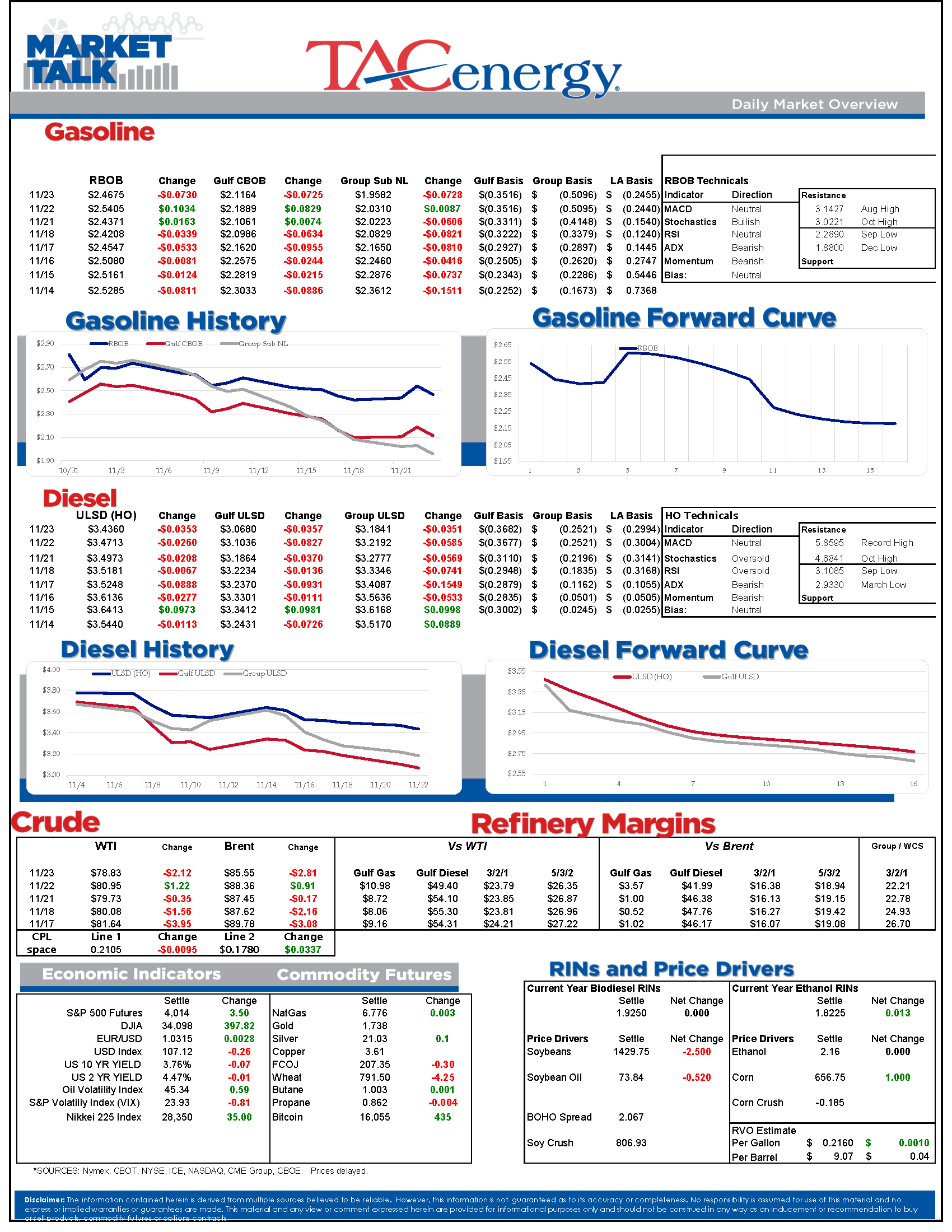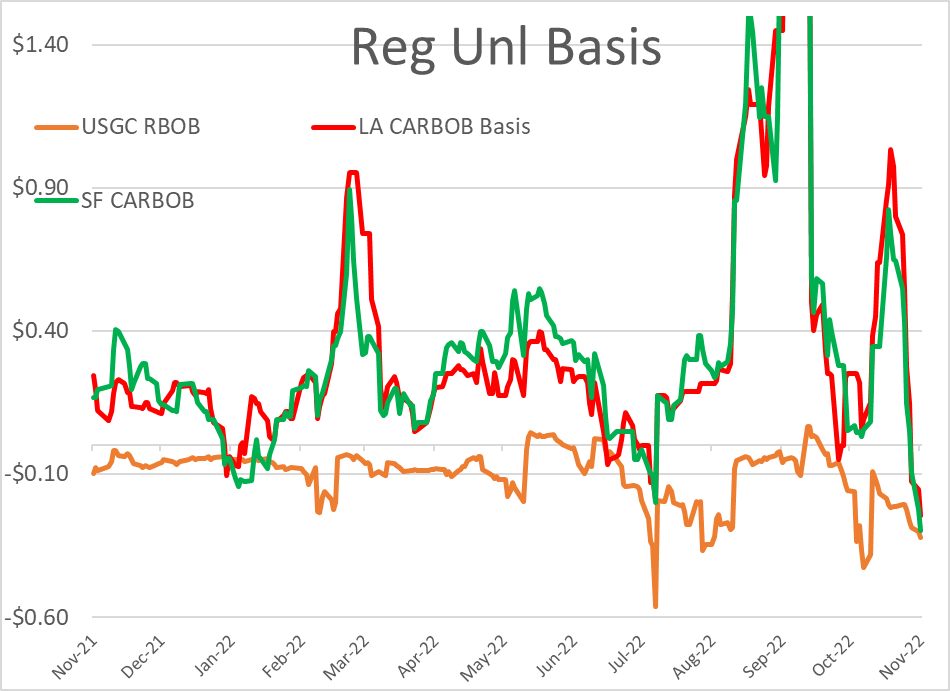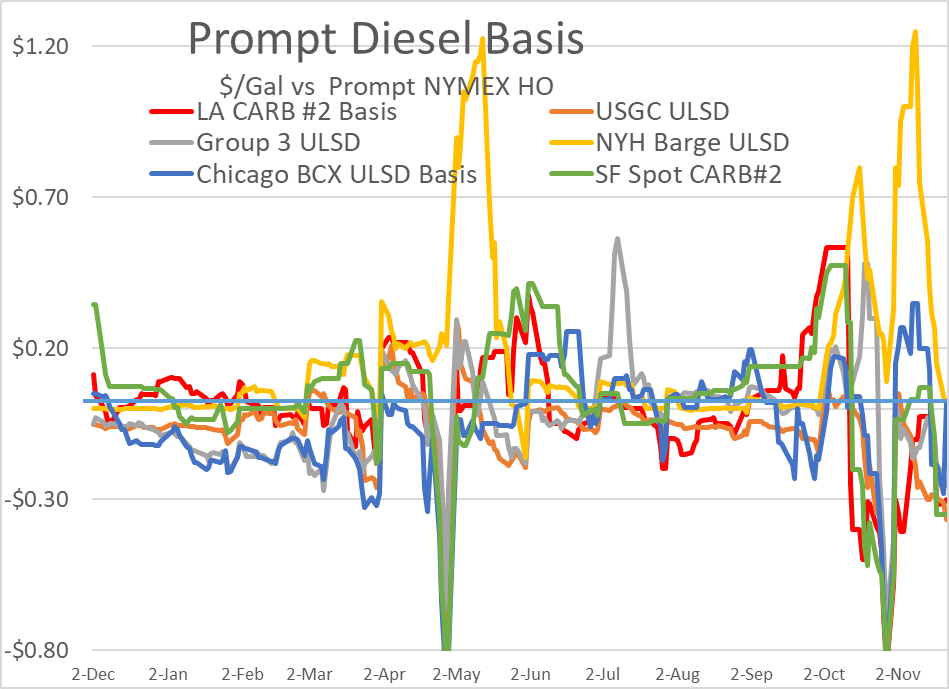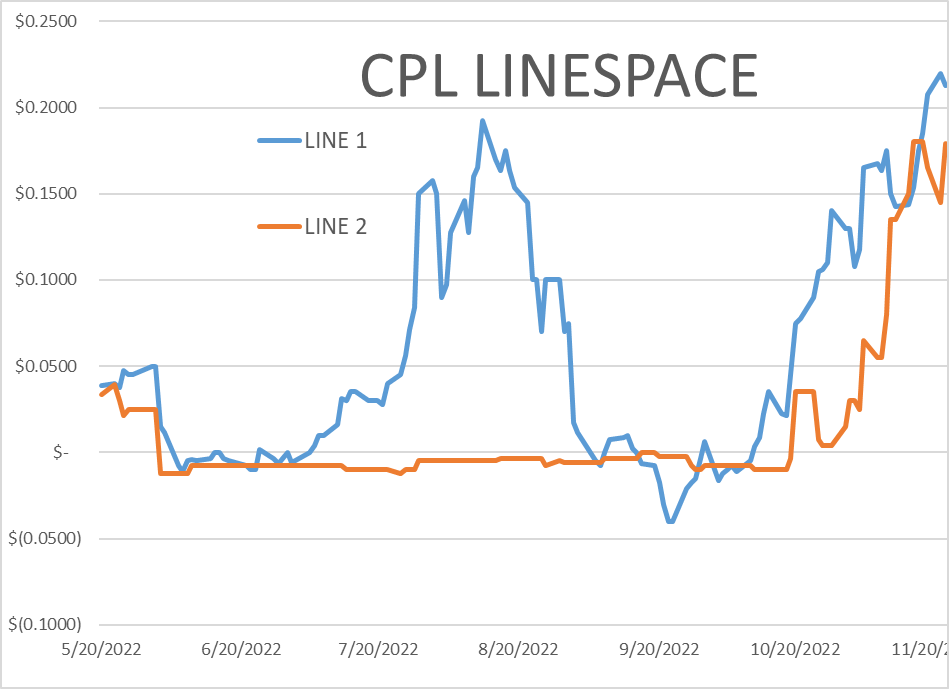Energy Futures Are Seeing A Big Pullback To Start Thanksgiving Eve Trading

Energy futures are seeing a big pullback to start Thanksgiving eve trading, wiping out most of Tuesday’s gains. As traders continue to deal with a daily deluge of dreadful demand headlines from China, offset by uncertainty surrounding supply thanks to OPEC rumors and a plan to cap Russian oil prices that leaves more questions than answers.
More refinery problems seem to have contributed to runup in RBOB futures in the early part of the week, although this morning’s pullback suggests the market really isn’t too worried about gasoline supply. Reports that the Irving refinery on the East Coast of Canada was facing challenges restarting after a major fall turnaround and that BP’s plant in Rotterdam was unable to restart due to a strike are both making waves in futures and physical markets, and could be key factors driving trading as we approach the end of November. Meanwhile, Bulgaria announced that it will exempt its refinery owned by Russia’s Lukoil to continue exporting fuels after the EU embargo starts next month, adding yet another loophole to the attempted sanctions on Russian supplies.
Cash markets around most of the US weren’t buying the futures rally Tuesday, with basis values tumbling for both gasoline and diesel. On the West Coast, gasoline basis values have dropped to their lowest levels in 2 years with discounts ranging from 25-30 cents/gallon, just two weeks after trading at a $1/gallon premium to December RBOB futures. New York harbor diesel has completed its return to earth, trading at just a penny premium to December ULSD futures, just two weeks after reaching an all-time high of $1.25/gallon. Gulf Coast distillates continue to get hammered, trading at a 36 cent discount to Dec ULSD, as refiners continue to struggle to find enough transportation to move their product.
An often-overlooked detail in the breathless reporting of diesel shortages is that the US actually produces more than a million barrels/day more diesel than it consumes, with producers relying heavily on the export market to keep their facilities moving at maximum capacity. What seems to be happening lately is that the refinery hubs have plenty of supply as run rates have been maxed out, but pipeline and vessel availability is lacking, forcing huge discounts for generic origin barrels, and big premiums for anyone who has space along the pipelines heading East and West, or a ship that’s not already booked up. A prime example: With New York ULSD now trading close to par with futures, you might think that the price for space along Colonial would collapse, but it’s holding north of 15 cents as Gulf Coast refiners are paying up to find a home for the diesel they want so badly to continue overproducing given current margins.
The API reported that diesel stocks increased by 1.1 million barrels last week, while gasoline stocks declined by 400,000 barrels. Crude oil stocks declined by more than 4 million barrels, even though the SPR released more than a million barrels on the week, which has helped make that brief contango in WTI prices disappear. The DOE’s weekly report is due out at its normal time today, with the import/export flows key numbers to watch.
Futures will trade in abbreviated sessions Thursday and Friday but spot markets will not be assessed. Even though many would prefer if nothing happened for the next 4 days, rack prices can and will change over the long holiday weekend, especially if we see a big market move like we did last year.
RIN values continue to slowly but steadily climb to an 18 month high as the market awaits the EPA’s big announcement on its new plans for the RFS next week.
Click here to download a PDF of today's TACenergy Market Talk.
News & Views
View All
The Recovery Rally In Energy Markets Continues For A 3rd Day
The recovery rally in energy markets continues for a 3rd day with refined product futures both up more than a dime off of the multi-month lows we saw Wednesday morning. The DJIA broke 40,000 for the first time ever Thursday, and while it pulled back yesterday, US equity futures are suggesting the market will open north of that mark this morning, adding to the sends of optimism in the market.
Despite the bounce in the back half of the week, the weekly charts for both RBOB and ULSD are still painting a bearish outlook with a lower high and lower low set this week unless the early rally this morning can pick up steam in the afternoon. It does seem like the cycle of liquidation from hedge funds has ended however, so it would appear to be less likely that we’ll see another test of technical support near term after this bounce.
Ukraine hit another Russian refinery with a drone strike overnight, sparking a fire at Rosneft’s 240mb/day Tuapse facility on the black sea. That plant was one of the first to be struck by Ukrainian drones back in January and had just completed repairs from that strike in April. The attack was just one part of the largest drone attack to date on Russian energy infrastructure overnight, with more than 100 drones targeting power plants, fuel terminals and two different ports on the Black Sea. I guess that means Ukraine continues to politely ignore the White House request to stop blowing up energy infrastructure in Russia.
Elsewhere in the world where lots of things are being blown up: Several reports of a drone attack in Israel’s largest refining complex (just under 200kbd) made the rounds Thursday, although it remains unclear how much of that is propaganda by the attackers and if any impact was made on production.
The LA market had 2 different refinery upsets Thursday. Marathon reported an upset at the Carson section of its Los Angeles refinery in the morning (the Carson facility was combined with the Wilmington refinery in 2019 and now reports as a single unit to the state, but separately to the AQMD) and Chevron noted a “planned” flaring event Thursday afternoon. Diesel basis values in the region jumped 6 cents during the day. Chicago diesel basis also staged a recovery rally after differentials dropped past a 30 cent discount to futures earlier in the week, pushing wholesale values briefly below $2.10/gallon.
So far there haven’t been any reports of refinery disruptions from the severe weather than swept across the Houston area Thursday. Valero did report a weather-related upset at its Mckee refinery in the TX panhandle, although it appears they avoided having to take any units offline due to that event.
The Panama Canal Authority announced it was increasing its daily ship transit level to 31 from 24 as water levels in the region have recovered following more than a year of restrictions. That’s still lower than the 39 ships/day rate at the peak in 2021, but far better than the low of 18 ships per day that choked transit last year.
Click here to download a PDF of today's TACenergy Market Talk.

Energy Prices Found A Temporary Floor After Hitting New Multi-Month Lows Wednesday
Energy prices found a temporary floor after hitting new multi-month lows Wednesday morning as a rally to record highs in US equity markets and a modestly bullish DOE report both seemed to encourage buyers to step back into the ring.
RBOB and ULSD futures both bounced more than 6 cents off of their morning lows, following a CPI report that eased inflation fears and boosted hopes for the stock market’s obsession of the FED cutting interest rates. Even though the correlation between energy prices and equities and currencies has been weak lately, the spillover effect on the bidding was clear from the timing of the moves Wednesday.
The DOE’s weekly report seemed to add to the optimism seen in equity markets as healthy increases in the government’s demand estimates kept product inventories from building despite increased refinery runs.
PADD 3 diesel stocks dropped after large increases in each of the past 3 weeks pushed inventories from the low end of their seasonal range to average levels. PADD 2 inventories remain well above average which helps explain the slump in mid-continent basis values over the past week. Diesel demand showed a nice recovery on the week and would actually be above the 5 year average if the 5% or so of US consumption that’s transitioned to RD was included in these figures.
Gasoline inventories are following typical seasonal patterns except on the West Coast where a surge in imports helped inventories recover for a 3rd straight week following April’s big basis rally.
Refiners for the most part are also following the seasonal script, ramping up output as we approach the peak driving demand season which unofficially kicks off in 10 days. PADD 2 refiners didn’t seem to be learning any lessons from last year’s basis collapse and rapidly increased run rates last week, which is another contributor to the weakness in midwestern cash markets. One difference this year for PADD 2 refiners is the new Transmountain pipeline system has eroded some of their buying advantage for Canadian crude grades, although those spreads so far haven’t shrunk as much as some had feared.
Meanwhile, wildfires are threatening Canada’s largest oil sands hub Ft. McMurray Alberta, and more than 6,000 people have been forced to evacuate the area. So far no production disruptions have been reported, but you may recall that fires in this region shut in more than 1 million barrels/day of production in 2016, which helped oil prices recover from their slump below $30/barrel.
California’s Air Resources Board announced it was indefinitely delaying its latest California Carbon Allowance (CCA) auction – in the middle of the auction - due to technical difficulties, with no word yet from the agency when bidders’ security payments will be returned, which is pretty much a nice microcosm for the entire Cap & Trade program those credits enable.

